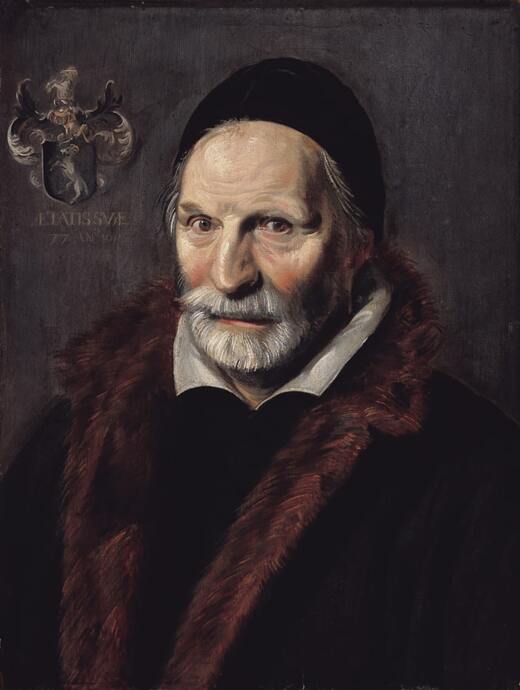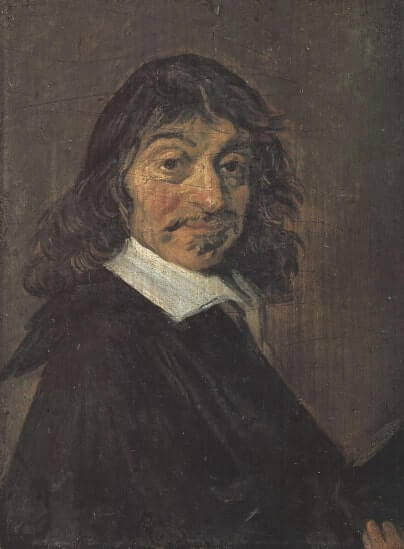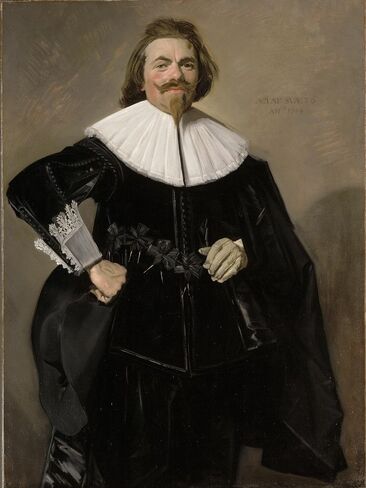|
Where? Room 17 of the Frans Hals Museum
When? 1611 Commissioned by? Jacobus Hendricksz. Zaffius What do you see? A life-size portrait of the 77-year old Jacobus Hendricksz. Zaffius. Frans Hals portrays Zaffius with his grey beard and mustache. Zaffius wears dark clothes with a fur cloak on top, a white collar, and a black cap. Hals paints him with a fairly serious expression. Zaffius looks to the left, which is the area where the light is coming from. Most of the face of Zaffius is illuminated by the light, and Hals uses darker colors to paint the left side of the face that is not in the light. Hals applies the paint smoothly and pays careful attention to the details in the portrait. However, compared to his colleagues, Hals somewhat broader brush strokes. Backstory: Frans Hals was 28 years old went he created this painting. He had only started as an independent artist the year before and was primarily working as an art restorer for the local guild of painters. This was the first commission that he received, and it was a great opportunity for Frans Hals to kickstart his desired career as a painter. He paints the portrait of 22 x 16 inch (55 c 41 cm) on a wood panel, which is the most popular medium for portraits of relatively small size. Who is Zaffius? Jacobus Hendricksz. Zaffius was a rich Catholic pastor, miniature painter, and environmental activist. Two years before he commissioned Frans Hals to paint his portrait, Zaffius had donated a considerable sum of money to expand an almshouse in Haarlem with five rooms. Jacobus Zaffius asked Hals to paint his portrait for the regent’s room of the almshouse. Zaffius was the official for the Catholic Church in Haarlem, even though the Catholic Church was officially forbidden. Who is Hals? Frans Hals was born in 1582/1583 in Antwerp, but his parents moved to Haarlem when Frans was about four years old. He would stay all his life in Haarlem where he would die at age 84. Frans Hals was a revolutionary painter. His broad and loose brush strokes were very different from other Baroque painters, and he was considered as one of the best painters in Haarlem during his life. He primarily focused on portraits, and about 80% of his surviving oeuvre consists of portraits of upper-class people. Among his more famous portraits are his Portrait of René Descartes in the Statens Museum for Kunst in Copenhagen and the Portrait of Tieleman Roosterman in the Cleveland Museum of Art.
Fun fact: During his career, Frans Hals constantly struggled with the tradeoff between following his revolutionary artistic ideas and fulfilling the wishes of his commissioners. Hals liked to use loose brush strokes and omit some traditional details from his portraits. By doing this, he was better able to bring out the personality of his sitter.
However, his commissioners were often not ready for Hals’ innovative approach, and Hals also had to make some money to support himself and his family. Early in his career, Hals was more willing to listen to the demands of his commissioners and thus make more traditional portraits. Interested in a copy for yourself? Poster
0 Comments
|
Categories
All
|
- Home
- Blog
-
Museums
- Alte Pinakothek
- Art Institute of Chicago
- Baltimore Museum of Art
- Barber Institute of Fine Arts
- Bargello
- Barnes Foundation
- British Museum
- Church of Sant’Anastasia
- Cleveland Museum of Art
- Courtauld Institute of Art
- Detroit Institute of Arts
- Frans Hals Museum
- Galleria Borghese
- Gallerie dell'Accademia
- Getty Museum
- Guggenheim
- Hermitage Museum
- Kunsthistorisches Museum
- Kunstmuseum Basel
- Legion of Honor Museum
- Louvre
- Mauritshuis
- Metropolitan Museum of Art
- Musee d’Orsay
- Museum of Fine Arts in Boston
- Museum of Modern Art
- National Gallery in London
- National Gallery of Art
- National Museum in Poznań
- Norton Simon Museum
- Ny Carlsberg Glyptotek
- Palace of Versailles
- Palazzo Pitti
- Palazzo Vecchio
- Petit Palais
- Philadelphia Museum of Art
- Prado
- Pushkin Museum
- Ravenna Art Museum
- Rijksmuseum
- San Diego Museum of Art
- Santa Maria delle Grazie
- St. Peter's Basilica
- Städel Museum
- Statens Museum for Kunst
- Tate Britain
- Tate Modern
- Timken Museum of Art
- Uffizi
- Vatican Museums
- Wallace Collection
-
Artists
- Altdorfer
- Anguissola
- Berlin Painter
- Bosch
- Botticelli
- Boucher
- Bronzino
- Bruegel the Elder
- Brunelleschi
- Cabanel
- Caillebotte
- Canova
- Caravaggio
- Carpeaux
- Cezanne
- Cimabue
- David
- Degas
- Delacroix
- De Maria
- Donatello
- El Greco
- Fontana
- Fra Angelico
- Fragonard
- Gauguin
- Gentileschi
- Gericault
- Gonzalez-Torres
- Goya
- Hals
- Hogarth
- Hokusai
- Ingres
- Leonardo da Vinci
- Lippi, Filippo
- Longhi, Barbara
- Lorrain
- Makovsky
- Manet
- Massys
- Matisse
- Merian
- Michelangelo
- Mochi
- Modigliani
- Monet
- Panini
- Parmigianino
- Perugino
- Picasso
- Pisanello
- Raphael
- Rembrandt
- Renoir
- Reynolds
- Rivera
- Rodin
- Rubens
- Scultori
- Seurat
- Steen
- Tintoretto
- Titian
- Toulouse-Lautrec
- Turner
- Uccello
- Van der Weyden
- Van Dyck
- Van Eyck
- Van Gogh
- Van Hemessen
- Vasari
- Velazquez
- Vermeer
- Veronese
- Vigée Le Brun
-
Locations
- Books
- About Us



